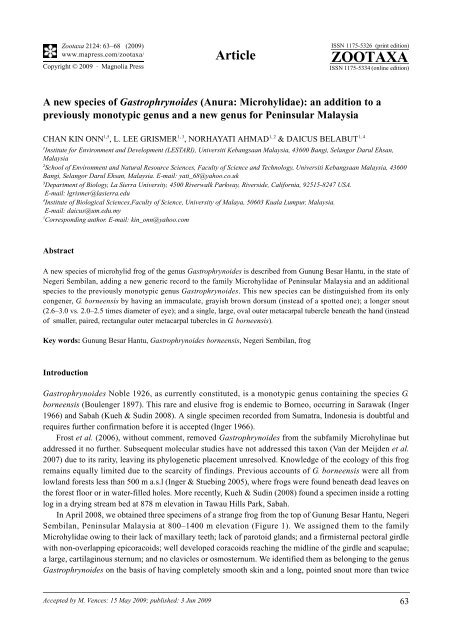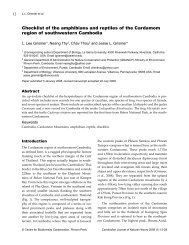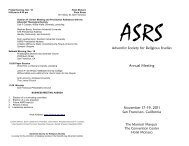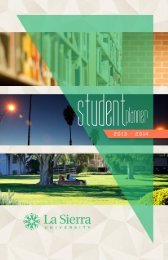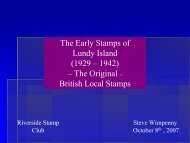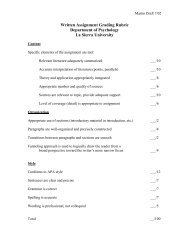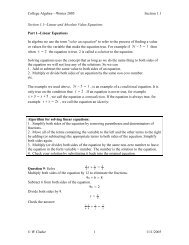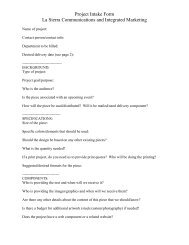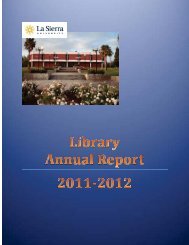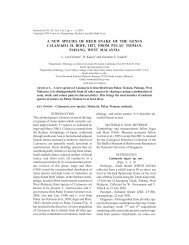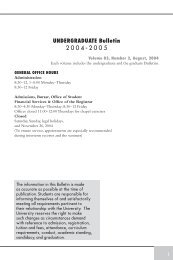Zootaxa, A new species of Gastrophrynoides - La Sierra University
Zootaxa, A new species of Gastrophrynoides - La Sierra University
Zootaxa, A new species of Gastrophrynoides - La Sierra University
Create successful ePaper yourself
Turn your PDF publications into a flip-book with our unique Google optimized e-Paper software.
TERMS OF USEThis pdf is provided by Magnolia Press for private/research use.Commercial sale or deposition in a public library or website is prohibited.<strong>Zootaxa</strong> 2124: 63–68 (2009)www.mapress.com/zootaxa/Copyright © 2009 · Magnolia PressArticleISSN 1175-5326 (print edition)ZOOTAXAISSN 1175-5334 (online edition)A <strong>new</strong> <strong>species</strong> <strong>of</strong> <strong>Gastrophrynoides</strong> (Anura: Microhylidae): an addition to apreviously monotypic genus and a <strong>new</strong> genus for Peninsular MalaysiaCHAN KIN ONN 1,5 , L. LEE GRISMER 1, 3 , NORHAYATI AHMAD 1, 2 & DAICUS BELABUT 1, 41Institute for Environment and Development (LESTARI), Universiti Kebangsaan Malaysia, 43600 Bangi, Selangor Darul Ehsan,Malaysia2School <strong>of</strong> Environment and Natural Resource Sciences, Faculty <strong>of</strong> Science and Technology, Universiti Kebangsaan Malaysia, 43600Bangi, Selangor Darul Ehsan, Malaysia. E-mail: yati_68@yahoo.co.uk3Department <strong>of</strong> Biology, <strong>La</strong> <strong>Sierra</strong> <strong>University</strong>, 4500 Riverwalk Parkway, Riverside, California, 92515-8247 USA.E-mail: lgrismer@lasierra.edu4Institute <strong>of</strong> Biological Sciences,Faculty <strong>of</strong> Science, <strong>University</strong> <strong>of</strong> Malaya, 50603 Kuala Lumpur, Malaysia.E-mail: daicus@um.edu.my5Corresponding author. E-mail: kin_onn@yahoo.comAbstractA <strong>new</strong> <strong>species</strong> <strong>of</strong> microhylid frog <strong>of</strong> the genus <strong>Gastrophrynoides</strong> is described from Gunung Besar Hantu, in the state <strong>of</strong>Negeri Sembilan, adding a <strong>new</strong> generic record to the family Microhylidae <strong>of</strong> Peninsular Malaysia and an additional<strong>species</strong> to the previously monotypic genus <strong>Gastrophrynoides</strong>. This <strong>new</strong> <strong>species</strong> can be distinguished from its onlycongener, G. borneensis by having an immaculate, grayish brown dorsum (instead <strong>of</strong> a spotted one); a longer snout(2.6–3.0 vs. 2.0–2.5 times diameter <strong>of</strong> eye); and a single, large, oval outer metacarpal tubercle beneath the hand (instead<strong>of</strong> smaller, paired, rectangular outer metacarpal tubercles in G. borneensis).Key words: Gunung Besar Hantu, <strong>Gastrophrynoides</strong> borneensis, Negeri Sembilan, frogIntroduction<strong>Gastrophrynoides</strong> Noble 1926, as currently constituted, is a monotypic genus containing the <strong>species</strong> G.borneensis (Boulenger 1897). This rare and elusive frog is endemic to Borneo, occurring in Sarawak (Inger1966) and Sabah (Kueh & Sudin 2008). A single specimen recorded from Sumatra, Indonesia is doubtful andrequires further confirmation before it is accepted (Inger 1966).Frost et al. (2006), without comment, removed <strong>Gastrophrynoides</strong> from the subfamily Microhylinae butaddressed it no further. Subsequent molecular studies have not addressed this taxon (Van der Meijden et al.2007) due to its rarity, leaving its phylogenetic placement unresolved. Knowledge <strong>of</strong> the ecology <strong>of</strong> this frogremains equally limited due to the scarcity <strong>of</strong> findings. Previous accounts <strong>of</strong> G. borneensis were all fromlowland forests less than 500 m a.s.l (Inger & Stuebing 2005), where frogs were found beneath dead leaves onthe forest floor or in water-filled holes. More recently, Kueh & Sudin (2008) found a specimen inside a rottinglog in a drying stream bed at 878 m elevation in Tawau Hills Park, Sabah.In April 2008, we obtained three specimens <strong>of</strong> a strange frog from the top <strong>of</strong> Gunung Besar Hantu, NegeriSembilan, Peninsular Malaysia at 800–1400 m elevation (Figure 1). We assigned them to the familyMicrohylidae owing to their lack <strong>of</strong> maxillary teeth; lack <strong>of</strong> parotoid glands; and a firmisternal pectoral girdlewith non-overlapping epicoracoids; well developed coracoids reaching the midline <strong>of</strong> the girdle and scapulae;a large, cartilaginous sternum; and no clavicles or osmosternum. We identified them as belonging to the genus<strong>Gastrophrynoides</strong> on the basis <strong>of</strong> having completely smooth skin and a long, pointed snout more than twiceAccepted by M. Vences: 15 May 2009; published: 3 Jun 2009 63
TERMS OF USEThis pdf is provided by Magnolia Press for private/research use.Commercial sale or deposition in a public library or website is prohibited.the diameter <strong>of</strong> the eye. However, these frogs differ from G. borneensis in having an immaculate, grayishbrown dorsum as opposed to a spotted one, a longer snout (2.6–3.0 vs. 2.0–2.5 times diameter <strong>of</strong> eye), andhaving a single, large, oval outer metacarpal tubercle beneath the hand as opposed to smaller, paired,rectangular outer metacarpal tubercles in G. borneensis. Owing to a combination <strong>of</strong> differences inmorphology, color-pattern and geographic distribution, we evaluate this population within the framework <strong>of</strong> aGeneral Lineage Species Concept (De Queiroz 1998) and use morphological diagnosibility and geographicisolation (e.g. Grismer 1999; McGuire et al. 2007) as criteria for lineage independence. Given that this <strong>new</strong><strong>species</strong> <strong>of</strong> microhylid was found on an isolated mountain top on the west coast <strong>of</strong> Peninsular Malaysia,whereas G. borneensis, from which it is morphologically different, is restricted Borneo, there is no doubt thatthese two allopatric forms represent independent evolutionary lineages, and as such, we describe thePeninsular Malaysian population as a <strong>new</strong> <strong>species</strong>.FIGURE 1. Type locality <strong>of</strong> <strong>Gastrophrynoides</strong> immaculatus and distribution <strong>of</strong> G. borneensis.Materials and methodsSpecimens were photographed and liver tissue was taken prior to preservation and stored in 95% ethanol.Specimens were fixed with 10% formalin and stored in 70% ethanol. Measurements were taken withMitutoyo digimatic caliper to the nearest 0.1 mm. Radiographs were prepared using a Faxitron closed x-raysystem with an exposure time <strong>of</strong> 20 sec at 20 kV.Images were recorded on Polaroid type 55 film.Measurements taken: snout-vent-length (SVL), taken from tip <strong>of</strong> snout to vent; head length (HL), measuredfrom the posterior margin <strong>of</strong> lower jaw to tip <strong>of</strong> snout; head width (HW), taken immediately posterior to eyes;eye diameter (ED), distance between anterior and posterior corners <strong>of</strong> upper and lower eyelids; width <strong>of</strong> uppereyelid (ELW), measured from the base <strong>of</strong> upper eyelid to lateral edge at its widest point; interorbital distance(IOD), distance across top <strong>of</strong> head between medial margins <strong>of</strong> orbits at their closest points; snout length (SL),measured from anterior corner <strong>of</strong> the orbit to tip <strong>of</strong> snout; distance <strong>of</strong> eye to nostril (DETN), measured fromanterior corner <strong>of</strong> eye to posterior margin <strong>of</strong> nostril; distance <strong>of</strong> nostril to tip <strong>of</strong> snout (DNTS), measured fromanterior margin <strong>of</strong> nostril to tip <strong>of</strong> snout; internarial distance (IND), measured from medial inner margins <strong>of</strong>nostrils; tympanum diameter (TD), horizontal width <strong>of</strong> tympanum at its widest point; tibia length (TiL),measured from center <strong>of</strong> knee to center <strong>of</strong> ankle. All specimens have been deposited at the UniversitiKebangsaan Malaysia Herpetological Collection (HC), Bangi, Malaysia and <strong>La</strong> <strong>Sierra</strong> <strong>University</strong>Herpetological Collection (LSUHC), <strong>La</strong> <strong>Sierra</strong> <strong>University</strong>, Riverside, California, USA. FMNH refers to theField Museum <strong>of</strong> Natural History, Chicago, USA.64 · <strong>Zootaxa</strong> 2124 © 2009 Magnolia PressCHAN ET AL.
TERMS OF USEThis pdf is provided by Magnolia Press for private/research use.Commercial sale or deposition in a public library or website is prohibited.Systematics<strong>Gastrophrynoides</strong> immaculatus sp nov.Figure 2Suggested common name: Tung’s Narrow-mouthed FrogHolotype. HC00279 (Figure 2), adult female, collected April 2008 from Gunung Besar Hantu, NegeriSembilan, Peninsular Malaysia (Figure 1) by Orang Asli collectors at an elevation <strong>of</strong> 800–1400 meters a.s.l.Paratypes. HC00199, male; LSUHC 9166, female, collected from the same location as the holotype onthe same date.FIGURE 2. Holotype <strong>of</strong> <strong>Gastrophrynoides</strong> immaculatus (HC00279).Diagnosis. <strong>Gastrophrynoides</strong> immaculatus is distinguished from all other microhylids by having a long,pointed snout that is 2.6–3.0 times the diameter <strong>of</strong> the eye; smooth skin; immaculate, grayish brown dorsumwith no white spots; and a single, large, oval, outer metacarpal tubercle.Description <strong>of</strong> holotype. Adult female, SVL 29.3 mm; habitus robust; head slightly wider than long(HW/HL 1.06), triangular in dorsal pr<strong>of</strong>ile; snout long, 3.0 times diameter <strong>of</strong> eye, half the length <strong>of</strong> the head,rounded in lateral pr<strong>of</strong>ile, greatly projecting beyond lower jaw, ventral surface <strong>of</strong> projection concave; canthusrostralis indistinct; lores, flat, sloping; nostrils laterally placed, much closer to end <strong>of</strong> snout than to eye;internarial width less than interorbital width; interorbital width more than three times width <strong>of</strong> upper eyelid;eyes small, 25% <strong>of</strong> head length; pupil rounded, widely dilated; tympanum visible but obscured by skin,subcircular, as wide as high, slightly less than eye diameter; supratympanic fold weak.Skin smooth on all dorsal and ventral surfaces. Forelimbs moderately short, somewhat robust;F3>F2=F4>F1; finger tips expanded into small, round disks bearing circum-marginal grooves; finger disksequal or slightly wider than penultimate phalanges; subarticular and metacarpal tubercles weak; innermetacarpal tubercle small, oval; outer metacarpal tubercle large, oval; fingers free <strong>of</strong> web. Hind limbsA NEW SPECIES OF MICROHYLID<strong>Zootaxa</strong> 2124 © 2009 Magnolia Press · 65
TERMS OF USEThis pdf is provided by Magnolia Press for private/research use.Commercial sale or deposition in a public library or website is prohibited.moderate in length, robust;T4>T2=T3=T5>T1; toe tips expanded into small, round disks bearing circum-marginal grooves; toe disksslightly wider than penultimate phalanges; toes free <strong>of</strong> webbing; inner metatarsal tubercle ellipsoidal ;outermetatarsal tubercle absent (See appendix for additional measurements).Color in life. Uniform grayish brown above; cream with fine brown stippling (only visible undermicroscope) below.Color in alcohol. Dark gray above, dirty white below.Paratypes. Resemble holotype in coloration except the brown stippling beneath the limbs on HC00199and LSUHC 9166 is denser than that <strong>of</strong> the holotype (See appendix for measurements <strong>of</strong> type series).Comparisons. <strong>Gastrophrynoides</strong> immaculatus is distinguished from G. borneensis in having animmaculate, grayish brown dorsum as opposed to a spotted dorsum (Figure 2,3); a longer snout (2.6–3.0 vs.2.0–2.5 times diameter <strong>of</strong> eye); and a single, large, oval, outer metacarpal tubercle beneath the hand (vs.smaller, paired, rectangular outer metacarpal tubercles in G. borneensis).Distribution. Only known from the type locality in Gunung Besar Hantu, Negeri Sembilan (Figure 1).Natural History. The type series was found between 800–1400 m elevation in water-filled bamboo cutsnot more than 1 m above ground.FIGURE 3. <strong>Gastrophrynoides</strong> borneensis from Tawau Hills, Sabah. Photograph by Mr. Kueh Boon Hee.TABLE 1. Selected measurements (in mm) <strong>of</strong> type series. See materials and methods for abbreviations.HC00279 HC00199 LSUHC 9166SVL 29.3 24.4 26.2TiL 12.3 9.4 12.0ED 1.5 1.4 1.6HL 7.9 7.3 7.2HW 8.4 6.1 7.0SL 4.6 4.1 4.2DETN 2.8 2.2 2.1DNTS 1.7 1.4 1.9ELW 1.1 1.0 1.1IOD 3.8 3.1 3.0TD 1.2 1.0 1.4IND 2.7 2.4 2.666 · <strong>Zootaxa</strong> 2124 © 2009 Magnolia PressCHAN ET AL.
TERMS OF USEThis pdf is provided by Magnolia Press for private/research use.Commercial sale or deposition in a public library or website is prohibited.Etymology. The specific epithet is a latin masculine adjective in reference to the <strong>species</strong>’ uniformlycolored dorsum, which differentiates it from its only congener, G. borneensis. The proposed common name,Tung’s Narrow-mouthed Frog honors Mr. Leong Sung Tung, who discovered this frog and has contributedimmensely to the study and knowledge <strong>of</strong> herpet<strong>of</strong>auna in Peninsular Malaysia.DiscussionIt has been evident for many years that the mountain ranges <strong>of</strong> Peninsular Malaysia are regions <strong>of</strong> highherpetological diversity and endemism (e.g., Chan & Grismer 2008; Dring 1979; Grismer et al. 2008, 2009;Grismer 2006, 2007, 2008; Leong & Lim 2003; Wood et al. 2009). However, the majority <strong>of</strong> upland surveyshave focused only along well known and easily accessible areas (e.g. Genting Highlands, CameronHighlands, Fraser’s Hill, Bukit <strong>La</strong>rut), which account for only a small fraction <strong>of</strong> the elevated massifs <strong>of</strong>Peninsular Malaysia. The fact that a previously unreported genus has been discovered on an unexploredportion <strong>of</strong> the Titiwangsa Range brings to attention the dire need for surveys to be conducted in otherunexplored highlands along this extensive mountain corridor. The discovery <strong>of</strong> a <strong>Gastrophrynoides</strong> inPeninsular Malaysia is not surprising but is consistent with known prehistoric land connections between theMalay Peninsula, Borneo, Sumatra and Java, which resulted from lowered sea levels during the Pleistoceneglaciations (Inger 1966; Heaney 1986; Hall 1996, 1998). This is reflected in relatively high similarity indicesbetween Borneo and Peninsular Malaysia (Inger & Voris 2001).AcknowledgementsWe thank Robert Inger from the Field Museum <strong>of</strong> Natural History, Chicago, USA, and Alexander Haas from<strong>University</strong> <strong>of</strong> Hamburg, Germany, for their valuable insights and help in identification. We thank Kueh BoonHee from the Institute for Tropical Biology and Conservation, <strong>University</strong> Malaysia Sabah for allowing us touse his photograph. For the loan <strong>of</strong> materials we thank Alan Resetar <strong>of</strong> the Field Museum <strong>of</strong> Natural Historyand Aaron M. Bauer for the radiographs <strong>of</strong> the paratype LSUHC 9166.ReferencesBoulenger, M.A. (1897) Descriptions <strong>of</strong> <strong>new</strong> Malay Frogs. Annals and Magazine <strong>of</strong> Natural History, 19, 106–108.Chan, K.O. & Grismer, L.L. (2008) A <strong>new</strong> <strong>species</strong> <strong>of</strong> Cnemaspis Strauch 1887 (Squamata: Gekkonidae) from Selangor,Peninsular Malaysia. <strong>Zootaxa</strong>, 1877, 49–57.De Queiroz, K. (1998) The general lineage concept <strong>of</strong> <strong>species</strong>, <strong>species</strong> criteria, and the process <strong>of</strong> speciation: aconceptual unification and terminological recommendation. In: Howard, D.J. & Berlocher, S.H. (Eds.), Endlessforms, <strong>species</strong> and speciation. Oxford <strong>University</strong> Press, Oxford, pp. 57–75.Dring, J.C.M. (1979) Amphibians and reptiles from northern Terengganu, Malaysia, with descriptions <strong>of</strong> two <strong>new</strong>geckos: Cnemaspis and Cyrtodactylus. Bulletin <strong>of</strong> the British Museum <strong>of</strong> Natural History, 34, 181–241.Frost, D.R., Grant, T., Faivovich, J., Bain, R.H., Haas, A., Haddad, C.F.B., De Sá, R.O., Channing, A., Wilkinson, M.,Donnellan, S.C., Raxworthy, C.J., Campbell, J.A., Blotto, B.L., Moler, P., Drewes, R.C., Nussbaum, R.A., Lynch,J.D., Green, D.M. & Wheeler, W.C. (2006). The amphibian tree <strong>of</strong> life. Bulletin <strong>of</strong> the American Museum <strong>of</strong> NaturalHistory, 297, 1–370.Grismer, L. L. (1999) An evolutionary classification <strong>of</strong> reptiles on islands in the Gulf <strong>of</strong> California, Mexico.Herpetologica, 55, 446–469.Grismer, L. L., Norhayati A., Chan, K. O., Daicus, B., Muin, M. A., Wood, P. L. Jr., Grismer, J. L. (2009) Two <strong>new</strong>diminutive <strong>species</strong> <strong>of</strong> Cnemaspis Strauch 1887 (Squamata: Gekkonidae) from Peninsular Malaysia. <strong>Zootaxa</strong>, 2019,40–56.Grismer, L.L. (2006) A <strong>new</strong> <strong>species</strong> <strong>of</strong> Ansonia Stoliczka 1872 (Anura: Bufonidae) from central peninsular Malaysia anda revised taxonomy for Ansonia from the Malay Peninsula. <strong>Zootaxa</strong>, 1327, 1–21.A NEW SPECIES OF MICROHYLID<strong>Zootaxa</strong> 2124 © 2009 Magnolia Press · 67
TERMS OF USEThis pdf is provided by Magnolia Press for private/research use.Commercial sale or deposition in a public library or website is prohibited.Grismer, L.L. (2007) A <strong>new</strong> <strong>species</strong> <strong>of</strong> small montane forest floor skink (Genus Sphenomorphus Fitzinger 1843) fromsouthern Peninsular Malaysia. Herpetologica, 63, 544–551.Grismer, L.L. (2008) A <strong>new</strong> <strong>species</strong> <strong>of</strong> insular skink (Genus Sphenomorphus Fitzinger 1843) from the <strong>La</strong>ngkawiArchipelago, Kedah, West Malaysia with the first report <strong>of</strong> the herpet<strong>of</strong>auna <strong>of</strong> Pulau Singa Besar and an updatedchecklist <strong>of</strong> the herpet<strong>of</strong>auna <strong>of</strong> Pulau <strong>La</strong>ngkawi. <strong>Zootaxa</strong>, 1691, 53–66.Grismer, L.L., Grismer, J.L., Wood, P.L.Jr. & Chan, K.O. (2008) The distribution, taxonomy, and redescription <strong>of</strong> thegeckos Cnemaspis affinis (Stoliczka 1887) and C. flavolineata (Nicholls 1949) with descriptions <strong>of</strong> a <strong>new</strong> montane<strong>species</strong> and two <strong>new</strong> lowland, karst- dwelling <strong>species</strong> from Peninsular Malaysia. <strong>Zootaxa</strong>, 1931, 1–24.Hall, R. (1996) Reconstructing Cenozoic SE Asia. In: Hall, R. & Blundel, D. J. (Eds.), Tectonic evolution <strong>of</strong> SoutheastAsia. Geological Society Publishing House, Bath, pp. 153–183.Hall, R. (1998) The plate tectonics <strong>of</strong> Cenozoic SE Asia and thedistribution <strong>of</strong> land and sea. In: Hall, R. & Holloway, J. D. (Eds.), Biogeography and geological evolution <strong>of</strong> SoutheastAsia. Brackhuys Publishers, Leiden, pp. 99–132.Heaney, L. R. (1986) Biogeography <strong>of</strong> small mammals in SE Asia: estimates <strong>of</strong> rates <strong>of</strong> colonization, extinction andspeciation. Biological Journal <strong>of</strong> the Linnean Society, 28, 127–165.Inger, R.F. (1966) The Systematics and Zoogeography <strong>of</strong> the Amphibia <strong>of</strong> Borneo. Fieldiana : Zoology. Volume 52. FieldMuseum <strong>of</strong> Natural History, Chicago, U.S.A. 402 pp.Inger, R. F. & Voris, H. K. (2001) The biogeographical relations <strong>of</strong> the frogs and snakes <strong>of</strong> Sundaland. Journal <strong>of</strong>Biogeography, 28, 863–891.Inger, R.F. & Stuebing, R.B. (2005) A Field Guide to the Frogs <strong>of</strong> Borneo. Second Edition. Natural History Publications(Borneo) Sdn Bhd. Kota Kinabalu, Sabah, Malaysia. viii + 201 pp.Kueh, B. H. & Sudin, A. (2008) <strong>Gastrophrynoides</strong> borneensis range extension. Herpetological Review, 29(3), 363.Leong, T. M. & Lim, B.L. (2003) A <strong>new</strong> <strong>species</strong> <strong>of</strong> Rana (Amphibia: Anura: Ranidae) from the highlands <strong>of</strong> the MalayPeninsula. Raffles Bulletin <strong>of</strong> Zoology, 51, 115–122.McGuire, J. A., Brown, R. M., Mumpuni, Riyanto, A. & Andayani, N. (2007) The flying lizards <strong>of</strong> the Draco lineatusgroup (Squamata: Iguania: Agamidae): A taxonomic revision with descriptions <strong>of</strong> two <strong>new</strong> <strong>species</strong>. HerpetologicalMonographs, 21, 180–213.Van der Meijden, A., Vences, M., Hoegg, S., Boistel, R., Channing, A. & Meyer, A. (2007) Nuclear gene phylogeny <strong>of</strong>narrow-mouthed toads (Family Microhylidae) and a discussion <strong>of</strong> competing hypotheses concerning theirbiogeographical origins. Molecular Phylogenetics and Evolution, 44, 1017–1030.Wood, P. L. Jr., Grismer, J. L., Grismer, L. L., Norhayati, A., Chan, K. O., Bauer, A. (2009) Two <strong>new</strong> montane <strong>species</strong> <strong>of</strong>Acanthosaura Gray, 1831 (Squamata: Agamidae) from Peninsular Malaysia. <strong>Zootaxa</strong>, 2012, 28–46.Appendix. Materials examined<strong>Gastrophrynoides</strong> borneensisMalaysia: Sarawak: 3 rd Division, Kapit District, Mengiong River, Nanga Tekalit camp (FMNH 145314).Sarawak: 4 th Division, Bintulu District, Tubau camp on Sungai Pesu (FMNH 157179).Sarawak: 7 th Division, Kapit District, Nanga Tekalit (FMNH 223101).68 · <strong>Zootaxa</strong> 2124 © 2009 Magnolia PressCHAN ET AL.


